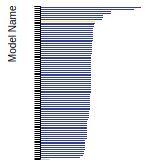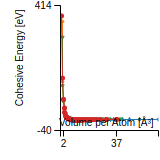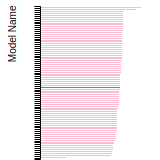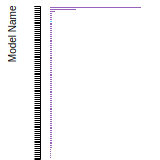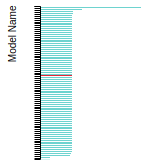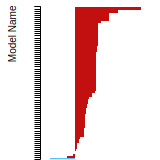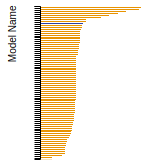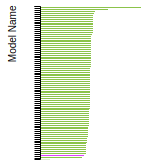 SNAP_LiHuChen_2018_Ni__MO_913991514986_000
SNAP_LiHuChen_2018_Ni__MO_913991514986_000
| Title
A single sentence description.
|
A spectral neighbor analysis potential for Ni developed by Xiangguo Li (2019) v000 |
|---|---|
| Description
A short description of the Model describing its key features including for example: type of model (pair potential, 3-body potential, EAM, etc.), modeled species (Ac, Ag, ..., Zr), intended purpose, origin, and so on.
|
A spectral neighbor analysis potential for Ni. The potential is trained against diverse and large materials data, including bulk fcc Ni, strained fcc Ni, ab-initio molecular dynamics (AIMD) simulated random structures, melted structures, surfaces, strained melted structures. The potential gives accurate predictions of structural energies, forces, elasticity, lattice parameters, vacancy migration barrier, equation-of-state, phonon, free energies, melting point, and surface energies. |
| Species
The supported atomic species.
| Ni |
| Disclaimer
A statement of applicability provided by the contributor, informing users of the intended use of this KIM Item.
|
This potential is designed for Ni fcc systems. It is not appropriate for other elements. The potential was trained using LAMMPS version 17Nov2016. Newer LAMMPS may see energy differences, but the relative values should remain to be the same. |
| Content Other Locations |
https://doi.org/10.1103/PhysRevB.98.094104 https://arxiv.org/abs/1806.04777 |
| Contributor |
Xiangguo Li |
| Maintainer |
Xiangguo Li |
| Developer |
Chongze Hu Jian Luo Xiangguo Li Chi Chen Deng, Zhi Ong, Shyue Ping |
| Published on KIM | 2020 |
| How to Cite |
This Model originally published in [1] is archived in OpenKIM [2-5]. [1] Li X-G, Hu C, Chen C, Deng Z, Luo J, Ong SP. Quantum-Accurate Spectral Neighbor Analysis Potential Models for Ni-Mo Binary Alloys and Fcc Metals. Physical Review B. 2018Sep;98(9):094104. doi:10.1103/PhysRevB.98.094104 — (Primary Source) A primary source is a reference directly related to the item documenting its development, as opposed to other sources that are provided as background information. [2] Hu C, Luo J, Li X, Chen C, Deng Z, Ong SP. A spectral neighbor analysis potential for Ni developed by Xiangguo Li (2019) v000. OpenKIM; 2020. doi:10.25950/4e758263 [3] Afshar Y, Thompson AP, Swiler LP, Trott CR, Foiles SM, Tucker GJ. Spectral neighbor analysis potential (SNAP) model driver v000. OpenKIM; 2019. doi:10.25950/f4fae493 [4] Tadmor EB, Elliott RS, Sethna JP, Miller RE, Becker CA. The potential of atomistic simulations and the Knowledgebase of Interatomic Models. JOM. 2011;63(7):17. doi:10.1007/s11837-011-0102-6 [5] Elliott RS, Tadmor EB. Knowledgebase of Interatomic Models (KIM) Application Programming Interface (API). OpenKIM; 2011. doi:10.25950/ff8f563a Click here to download the above citation in BibTeX format. |
| Citations
This panel presents information regarding the papers that have cited the interatomic potential (IP) whose page you are on. The OpenKIM machine learning based Deep Citation framework is used to determine whether the citing article actually used the IP in computations (denoted by "USED") or only provides it as a background citation (denoted by "NOT USED"). For more details on Deep Citation and how to work with this panel, click the documentation link at the top of the panel. The word cloud to the right is generated from the abstracts of IP principle source(s) (given below in "How to Cite") and the citing articles that were determined to have used the IP in order to provide users with a quick sense of the types of physical phenomena to which this IP is applied. The bar chart shows the number of articles that cited the IP per year. Each bar is divided into green (articles that USED the IP) and blue (articles that did NOT USE the IP). Users are encouraged to correct Deep Citation errors in determination by clicking the speech icon next to a citing article and providing updated information. This will be integrated into the next Deep Citation learning cycle, which occurs on a regular basis. OpenKIM acknowledges the support of the Allen Institute for AI through the Semantic Scholar project for providing citation information and full text of articles when available, which are used to train the Deep Citation ML algorithm. |
This panel provides information on past usage of this interatomic potential (IP) powered by the OpenKIM Deep Citation framework. The word cloud indicates typical applications of the potential. The bar chart shows citations per year of this IP (bars are divided into articles that used the IP (green) and those that did not (blue)). The complete list of articles that cited this IP is provided below along with the Deep Citation determination on usage. See the Deep Citation documentation for more information. 
56 Citations (15 used)
Help us to determine which of the papers that cite this potential actually used it to perform calculations. If you know, click the .
USED (high confidence) X.-G. Li, S. Xu, Q. Zhang, S. Liu, and J. Shuai, “Complex strengthening mechanisms in nanocrystalline Ni-Mo alloys revealed by a machine-learning interatomic potential,” Journal of Alloys and Compounds. 2023. link Times cited: 2 USED (high confidence) B. Waters, D. S. Karls, I. Nikiforov, R. Elliott, E. Tadmor, and B. Runnels, “Automated determination of grain boundary energy and potential-dependence using the OpenKIM framework,” Computational Materials Science. 2022. link Times cited: 5 USED (high confidence) T. Lee et al., “Atomic-scale origin of the low grain-boundary resistance in perovskite solid electrolyte Li0.375Sr0.4375Ta0.75Zr0.25O3,” Nature Communications. 2022. link Times cited: 9 USED (high confidence) H. Zheng et al., “Multi-scale investigation of short-range order and dislocation glide in MoNbTi and TaNbTi multi-principal element alloys,” npj Computational Materials. 2022. link Times cited: 8 USED (low confidence) T. Miryashkin, O. Klimanova, V. Ladygin, and A. Shapeev, “Bayesian inference of composition-dependent phase diagrams,” ArXiv. 2023. link Times cited: 0 Abstract: Phase diagrams serve as a highly informative tool for materi… read more USED (low confidence) A. A. Mamun, S. Xu, X.-G. Li, and Y. Su, “Comparing interatomic potentials in calculating basic structural parameters and Peierls stress in tungsten-based random binary alloys,” Physica Scripta. 2023. link Times cited: 0 Abstract: The field of machine learning-based interatomic potentials (… read more USED (low confidence) A. Verma, O. K. Johnson, G. Thompson, I. Chesser, S. Ogata, and E. Homer, “Insights into factors that affect non-Arrhenius migration of a simulated incoherent Σ3 grain boundary,” Acta Materialia. 2023. link Times cited: 2 USED (low confidence) S. Risal et al., “Development of the RF-MEAM Interatomic Potential for the Fe-C System to Study the Temperature-Dependent Elastic Properties,” Materials. 2023. link Times cited: 0 Abstract: One of the major impediments to the computational investigat… read more USED (low confidence) H. Deng, J. Comer, and B. Liu, “A high-dimensional neural network potential for molecular dynamics simulations of condensed phase nickel and phase transitions,” Molecular Simulation. 2022. link Times cited: 0 Abstract: ABSTRACT A high-dimensional neural network interatomic poten… read more USED (low confidence) J. Luo, “Computing grain boundary ‘phase’ diagrams,” Interdisciplinary Materials. 2022. link Times cited: 6 Abstract: Grain boundaries (GBs) can be treated as two‐dimensional (2‐… read more USED (low confidence) S. Oh, J.-S. Kim, C. S. Park, and B.-J. Lee, “Second nearest-neighbor modified embedded-atom method interatomic potentials for the Mo-M (M = Al, Co, Cr, Fe, Ni, Ti) binary alloy systems,” Computational Materials Science. 2021. link Times cited: 5 USED (low confidence) S. Fujii and A. Seko, “Structure and lattice thermal conductivity of grain boundaries in silicon by using machine learning potential and molecular dynamics,” Computational Materials Science. 2021. link Times cited: 8 USED (low confidence) X. Wang, S. Xu, W. Jian, X.-G. Li, Y. Su, and I. Beyerlein, “Generalized stacking fault energies and Peierls stresses in refractory body-centered cubic metals from machine learning-based interatomic potentials,” Computational Materials Science. 2021. link Times cited: 30 USED (low confidence) Y. Lysogorskiy et al., “Performant implementation of the atomic cluster expansion (PACE) and application to copper and silicon,” npj Computational Materials. 2021. link Times cited: 84 USED (low confidence) S. Xu, Y. Su, W. Jian, and I. Beyerlein, “Local slip resistances in equal-molar MoNbTi multi-principal element alloy,” Acta Materialia. 2021. link Times cited: 48 NOT USED (low confidence) X. Chen et al., “TensorMD: Scalable Tensor-Diagram based Machine Learning Interatomic Potential on Heterogeneous Many-Core Processors,” ArXiv. 2023. link Times cited: 0 Abstract: Molecular dynamics simulations have emerged as a potent tool… read more NOT USED (low confidence) C. Hong et al., “Applications and training sets of machine learning potentials,” Science and Technology of Advanced Materials: Methods. 2023. link Times cited: 0 Abstract: ABSTRACT Recently, machine learning potentials (MLPs) have b… read more NOT USED (low confidence) P. Ouyang et al., “Atomic Local Ordering and Alloying Effects on the Mg3(Sb1-xBix)2 Thermoelectric Material.,” ACS applied materials & interfaces. 2023. link Times cited: 1 Abstract: Mg3(Sb1-xBix)2 alloy has been extensively studied in the las… read more NOT USED (low confidence) Z. Ma and Z. Pan, “Efficient machine learning of solute segregation energy based on physics-informed features,” Scientific Reports. 2023. link Times cited: 0 NOT USED (low confidence) R. Zhao et al., “Development of a Neuroevolution Machine Learning Potential of Pd-Cu-Ni-P Alloys,” SSRN Electronic Journal. 2023. link Times cited: 2 NOT USED (low confidence) K. Pitike and W. Setyawan, “Accurate Fe–He machine learning potential for studying He effects in BCC-Fe,” Journal of Nuclear Materials. 2022. link Times cited: 1 NOT USED (low confidence) Z. Xu and Y. Xia, “Progress, challenges and perspectives of computational studies on glassy superionic conductors for solid-state batteries,” Journal of Materials Chemistry A. 2022. link Times cited: 2 Abstract: Sulfide-based glasses and glass-ceramics showing high ionic … read more NOT USED (low confidence) T. Wen, L. Zhang, H. Wang, W. E, and D. Srolovitz, “Deep Potentials for Materials Science,” Materials Futures. 2022. link Times cited: 54 Abstract:
To fill the gap between accurate (and expensive) ab initio… read more NOT USED (low confidence) K. Xie et al., “Neural network potential for Zr–Rh system by machine learning,” Journal of Physics: Condensed Matter. 2021. link Times cited: 3 Abstract: Zr–Rh metallic glass has enabled its many applications in ve… read more NOT USED (low confidence) X. Chen et al., “Machine learning enhanced empirical potentials for metals and alloys,” Comput. Phys. Commun. 2021. link Times cited: 5 NOT USED (low confidence) I. A. Balyakin, S. Rempel, R. Ryltsev, and A. Rempel, “Deep machine learning interatomic potential for liquid silica.,” Physical review. E. 2020. link Times cited: 16 Abstract: The use of machine learning to develop neural network potent… read more NOT USED (low confidence) H. Yanxon, D. Zagaceta, B. Tang, D. Matteson, and Q. Zhu, “PyXtal_FF: a python library for automated force field generation,” Machine Learning: Science and Technology. 2020. link Times cited: 15 Abstract: We present PyXtal_FF—a package based on Python programming l… read more NOT USED (low confidence) X. Chen, X. Gao, Y. Zhao, D. Lin, W. Chu, and H. Song, “TensorAlloy: An automatic atomistic neural network program for alloys,” Comput. Phys. Commun. 2020. link Times cited: 10 NOT USED (low confidence) A. V. der Ven, Z. Deng, S. Banerjee, and S. Ong, “Rechargeable Alkali-Ion Battery Materials: Theory and Computation.,” Chemical reviews. 2020. link Times cited: 116 Abstract: Since its development in the 1970s, the rechargeable alkali-… read more NOT USED (low confidence) Y. Zuo et al., “A Performance and Cost Assessment of Machine Learning Interatomic Potentials.,” The journal of physical chemistry. A. 2019. link Times cited: 413 Abstract: Machine learning of the quantitative relationship between lo… read more NOT USED (low confidence) S. Ong, “Accelerating materials science with high-throughput computations and machine learning,” Computational Materials Science. 2019. link Times cited: 66 NOT USED (low confidence) I. A. Balyakin and S. Sadovnikov, “Deep learning potential for superionic phase of Ag2S,” Computational Materials Science. 2022. link Times cited: 9 NOT USED (high confidence) M. Minotakis, H. Rossignol, M. Cobelli, and S. Sanvito, “Machine-learning surrogate model for accelerating the search of stable ternary alloys,” Physical Review Materials. 2023. link Times cited: 1 Abstract: The prediction of phase diagrams in the search for new phase… read more NOT USED (high confidence) X. Yuan, Y. Zhou, Q. Peng, Y. Yang, Y.-wang Li, and X. Wen, “Active learning to overcome exponential-wall problem for effective structure prediction of chemical-disordered materials,” npj Computational Materials. 2023. link Times cited: 7 NOT USED (high confidence) Z. Chen, F. Bononi, C. A. Sievers, W. Kong, and D. Donadio, “UV-Visible Absorption Spectra of Solvated Molecules by Quantum Chemical Machine Learning.,” Journal of chemical theory and computation. 2021. link Times cited: 6 Abstract: Predicting UV-visible absorption spectra is essential to und… read more NOT USED (high confidence) W.-Z. L. S.-Z. Yu et al., “Machine‐learning‐based interatomic potentials for advanced manufacturing,” International Journal of Mechanical System Dynamics. 2021. link Times cited: 2 Abstract: This paper summarizes the progress of machine‐learning‐based… read more NOT USED (high confidence) R. Ryltsev and N. Chtchelkatchev, “Deep machine learning potentials for multicomponent metallic melts: development, predictability and compositional transferability,” Journal of Molecular Liquids. 2021. link Times cited: 23 NOT USED (high confidence) J. Qi et al., “Bridging the gap between simulated and experimental ionic conductivities in lithium superionic conductors,” Materials Today Physics. 2021. link Times cited: 33 NOT USED (high confidence) Y. Mishin, “Machine-Learning Interatomic Potentials for Materials Science,” Electrical Engineering eJournal. 2021. link Times cited: 103 NOT USED (high confidence) Y.-S. Lin, G. P. P. Pun, and Y. Mishin, “Development of a physically-informed neural network interatomic potential for tantalum,” Computational Materials Science. 2021. link Times cited: 9 NOT USED (high confidence) Y. Liu, J.-yue Yang, G. Xin, L. Liu, G. Csányi, and B. Cao, “Machine learning interatomic potential developed for molecular simulations on thermal properties of β-Ga2O3.,” The Journal of chemical physics. 2020. link Times cited: 46 Abstract: The thermal properties of β-Ga2O3 can significantly affect t… read more NOT USED (high confidence) G. P. P. Pun, V. Yamakov, J. Hickman, E. Glaessgen, and Y. Mishin, “Development of a general-purpose machine-learning interatomic potential for aluminum by the physically informed neural network method,” Physical Review Materials. 2020. link Times cited: 13 Abstract: Interatomic potentials constitute the key component of large… read more NOT USED (high confidence) K. Shimizu, E. Arguelles, W. Li, Y. Ando, E. Minamitani, and S. Watanabe, “Phase stability of Au-Li binary systems studied using neural network potential,” Physical Review B. 2020. link Times cited: 7 Abstract: The miscibility of Au and Li exhibits a potential applicatio… read more NOT USED (high confidence) D. Zagaceta, H. Yanxon, and Q. Zhu, “Spectral neural network potentials for binary alloys,” Journal of Applied Physics. 2020. link Times cited: 4 Abstract: In this work, we present a numerical implementation to compu… read more NOT USED (high confidence) H.-hong Jia, D. Bao, Y. Zhang, and S. Du, “Structural and thermal stabilities of Au@Ag core-shell nanoparticles and their arrays: A molecular dynamics simulation,” Chinese Physics B. 2020. link Times cited: 3 NOT USED (high confidence) M. Cusentino, M. Wood, and A. Thompson, “Explicit Multi-element Extension of the Spectral Neighbor Analysis Potential for Chemically Complex Systems.,” The journal of physical chemistry. A. 2020. link Times cited: 35 Abstract: A natural extension of the descriptors used in the Spectral … read more NOT USED (high confidence) T. Mueller, A. Hernandez, and C. Wang, “Machine learning for interatomic potential models.,” The Journal of chemical physics. 2020. link Times cited: 189 Abstract: The use of supervised machine learning to develop fast and a… read more NOT USED (high confidence) C. Chen, Y. Zuo, W. Ye, X.-G. Li, Z. Deng, and S. Ong, “A Critical Review of Machine Learning of Energy Materials,” Advanced Energy Materials. 2020. link Times cited: 268 Abstract: Machine learning (ML) is rapidly revolutionizing many fields… read more NOT USED (high confidence) X.-G. Li, C. Chen, H. Zheng, Y. Zuo, and S. Ong, “Complex strengthening mechanisms in the NbMoTaW multi-principal element alloy,” npj Computational Materials. 2019. link Times cited: 114 NOT USED (high confidence) T. Wen et al., “Development of a deep machine learning interatomic potential for metalloid-containing Pd-Si compounds,” Physical Review B. 2019. link Times cited: 30 Abstract: Interatomic potentials based on neural-network machine learn… read more NOT USED (high confidence) J. Schmidt, M. R. G. Marques, S. Botti, and M. A. L. Marques, “Recent advances and applications of machine learning in solid-state materials science,” npj Computational Materials. 2019. link Times cited: 1226 NOT USED (high confidence) J. C. Thomas, J. S. Bechtel, A. Natarajan, and A. V. der Ven, “Machine learning the density functional theory potential energy surface for the inorganic halide perovskite
CsPbBr3,” Physical Review B. 2019. link Times cited: 7 Abstract: Structural phase transitions as a function of temperature di… read more NOT USED (high confidence) H. Zheng et al., “Grain boundary properties of elemental metals,” Acta Materialia. 2019. link Times cited: 98 NOT USED (high confidence) Z. Aitken, V. Sorkin, and Y.-W. Zhang, “Atomistic modeling of nanoscale plasticity in high-entropy alloys,” Journal of Materials Research. 2019. link Times cited: 32 Abstract: Lattice structures, defect structures, and deformation mecha… read more NOT USED (high confidence) M. Wood, M. Cusentino, B. Wirth, and A. Thompson, “Data-driven material models for atomistic simulation,” Physical Review B. 2019. link Times cited: 37 Abstract: The central approximation made in classical molecular dynami… read more NOT USED (high confidence) Z. Deng, C. Chen, X.-G. Li, and S. Ong, “An electrostatic spectral neighbor analysis potential for lithium nitride,” npj Computational Materials. 2019. link Times cited: 62 |
| Funding | Not available |
| Short KIM ID
The unique KIM identifier code.
| MO_913991514986_000 |
| Extended KIM ID
The long form of the KIM ID including a human readable prefix (100 characters max), two underscores, and the Short KIM ID. Extended KIM IDs can only contain alpha-numeric characters (letters and digits) and underscores and must begin with a letter.
| SNAP_LiHuChen_2018_Ni__MO_913991514986_000 |
| DOI |
10.25950/4e758263 https://doi.org/10.25950/4e758263 https://commons.datacite.org/doi.org/10.25950/4e758263 |
| KIM Item Type
Specifies whether this is a Portable Model (software implementation of an interatomic model); Portable Model with parameter file (parameter file to be read in by a Model Driver); Model Driver (software implementation of an interatomic model that reads in parameters).
| Portable Model using Model Driver SNAP__MD_536750310735_000 |
| Driver | SNAP__MD_536750310735_000 |
| KIM API Version | 2.0 |
| Potential Type | snap |
| Grade | Name | Category | Brief Description | Full Results | Aux File(s) |
|---|---|---|---|---|---|
| P | vc-species-supported-as-stated | mandatory | The model supports all species it claims to support; see full description. |
Results | Files |
| P | vc-periodicity-support | mandatory | Periodic boundary conditions are handled correctly; see full description. |
Results | Files |
| P | vc-permutation-symmetry | mandatory | Total energy and forces are unchanged when swapping atoms of the same species; see full description. |
Results | Files |
| A | vc-forces-numerical-derivative | consistency | Forces computed by the model agree with numerical derivatives of the energy; see full description. |
Results | Files |
| P | vc-dimer-continuity-c1 | informational | The energy versus separation relation of a pair of atoms is C1 continuous (i.e. the function and its first derivative are continuous); see full description. |
Results | Files |
| P | vc-objectivity | informational | Total energy is unchanged and forces transform correctly under rigid-body translation and rotation; see full description. |
Results | Files |
| P | vc-inversion-symmetry | informational | Total energy is unchanged and forces change sign when inverting a configuration through the origin; see full description. |
Results | Files |
| P | vc-memory-leak | informational | The model code does not have memory leaks (i.e. it releases all allocated memory at the end); see full description. |
Results | Files |
| P | vc-thread-safe | mandatory | The model returns the same energy and forces when computed in serial and when using parallel threads for a set of configurations. Note that this is not a guarantee of thread safety; see full description. |
Results | Files |
| N/A | vc-unit-conversion | mandatory | The model is able to correctly convert its energy and/or forces to different unit sets; see full description. |
Results | Files |
BCC Lattice Constant
This bar chart plot shows the mono-atomic body-centered cubic (bcc) lattice constant predicted by the current model (shown in the unique color) compared with the predictions for all other models in the OpenKIM Repository that support the species. The vertical bars show the average and standard deviation (one sigma) bounds for all model predictions. Graphs are generated for each species supported by the model.
Cohesive Energy Graph
This graph shows the cohesive energy versus volume-per-atom for the current mode for four mono-atomic cubic phases (body-centered cubic (bcc), face-centered cubic (fcc), simple cubic (sc), and diamond). The curve with the lowest minimum is the ground state of the crystal if stable. (The crystal structure is enforced in these calculations, so the phase may not be stable.) Graphs are generated for each species supported by the model.
Diamond Lattice Constant
This bar chart plot shows the mono-atomic face-centered diamond lattice constant predicted by the current model (shown in the unique color) compared with the predictions for all other models in the OpenKIM Repository that support the species. The vertical bars show the average and standard deviation (one sigma) bounds for all model predictions. Graphs are generated for each species supported by the model.
Dislocation Core Energies
This graph shows the dislocation core energy of a cubic crystal at zero temperature and pressure for a specific set of dislocation core cutoff radii. After obtaining the total energy of the system from conjugate gradient minimizations, non-singular, isotropic and anisotropic elasticity are applied to obtain the dislocation core energy for each of these supercells with different dipole distances. Graphs are generated for each species supported by the model.
(No matching species)FCC Elastic Constants
This bar chart plot shows the mono-atomic face-centered cubic (fcc) elastic constants predicted by the current model (shown in blue) compared with the predictions for all other models in the OpenKIM Repository that support the species. The vertical bars show the average and standard deviation (one sigma) bounds for all model predictions. Graphs are generated for each species supported by the model.
FCC Lattice Constant
This bar chart plot shows the mono-atomic face-centered cubic (fcc) lattice constant predicted by the current model (shown in red) compared with the predictions for all other models in the OpenKIM Repository that support the species. The vertical bars show the average and standard deviation (one sigma) bounds for all model predictions. Graphs are generated for each species supported by the model.
FCC Stacking Fault Energies
This bar chart plot shows the intrinsic and extrinsic stacking fault energies as well as the unstable stacking and unstable twinning energies for face-centered cubic (fcc) predicted by the current model (shown in blue) compared with the predictions for all other models in the OpenKIM Repository that support the species. The vertical bars show the average and standard deviation (one sigma) bounds for all model predictions. Graphs are generated for each species supported by the model.
FCC Surface Energies
This bar chart plot shows the mono-atomic face-centered cubic (fcc) relaxed surface energies predicted by the current model (shown in blue) compared with the predictions for all other models in the OpenKIM Repository that support the species. The vertical bars show the average and standard deviation (one sigma) bounds for all model predictions. Graphs are generated for each species supported by the model.
SC Lattice Constant
This bar chart plot shows the mono-atomic simple cubic (sc) lattice constant predicted by the current model (shown in the unique color) compared with the predictions for all other models in the OpenKIM Repository that support the species. The vertical bars show the average and standard deviation (one sigma) bounds for all model predictions. Graphs are generated for each species supported by the model.
Cubic Crystal Basic Properties Table
Species: NiDisclaimer From Model Developer
This potential is designed for Ni fcc systems. It is not appropriate for other elements. The potential was trained using LAMMPS version 17Nov2016. Newer LAMMPS may see energy differences, but the relative values should remain to be the same.
Creators:
Contributor: karls
Publication Year: 2019
DOI: https://doi.org/10.25950/64cb38c5
This Test Driver uses LAMMPS to compute the cohesive energy of a given monoatomic cubic lattice (fcc, bcc, sc, or diamond) at a variety of lattice spacings. The lattice spacings range from a_min (=a_min_frac*a_0) to a_max (=a_max_frac*a_0) where a_0, a_min_frac, and a_max_frac are read from stdin (a_0 is typically approximately equal to the equilibrium lattice constant). The precise scaling and number of lattice spacings sampled between a_min and a_0 (a_0 and a_max) is specified by two additional parameters passed from stdin: N_lower and samplespacing_lower (N_upper and samplespacing_upper). Please see README.txt for further details.
| Test | Test Results | Link to Test Results page | Benchmark time
Usertime multiplied by the Whetstone Benchmark. This number can be used (approximately) to compare the performance of different models independently of the architecture on which the test was run.
Measured in Millions of Whetstone Instructions (MWI) |
|---|---|---|---|
| Cohesive energy versus lattice constant curve for bcc Ni v004 | view | 3429 | |
| Cohesive energy versus lattice constant curve for diamond Ni v004 | view | 7343 | |
| Cohesive energy versus lattice constant curve for fcc Ni v004 | view | 6970 | |
| Cohesive energy versus lattice constant curve for sc Ni v004 | view | 2775 |
Creators: Junhao Li and Ellad Tadmor
Contributor: tadmor
Publication Year: 2019
DOI: https://doi.org/10.25950/5853fb8f
Computes the cubic elastic constants for some common crystal types (fcc, bcc, sc, diamond) by calculating the hessian of the energy density with respect to strain. An estimate of the error associated with the numerical differentiation performed is reported.
| Test | Test Results | Link to Test Results page | Benchmark time
Usertime multiplied by the Whetstone Benchmark. This number can be used (approximately) to compare the performance of different models independently of the architecture on which the test was run.
Measured in Millions of Whetstone Instructions (MWI) |
|---|---|---|---|
| Elastic constants for bcc Ni at zero temperature v006 | view | 2914 | |
| Elastic constants for diamond Ni at zero temperature v001 | view | 13535 | |
| Elastic constants for fcc Ni at zero temperature v006 | view | 4073 | |
| Elastic constants for sc Ni at zero temperature v006 | view | 13535 |
Creators:
Contributor: ilia
Publication Year: 2024
DOI: https://doi.org/10.25950/2f2c4ad3
Computes the equilibrium crystal structure and energy for an arbitrary crystal at zero temperature and applied stress by performing symmetry-constrained relaxation. The crystal structure is specified using the AFLOW prototype designation. Multiple sets of free parameters corresponding to the crystal prototype may be specified as initial guesses for structure optimization. No guarantee is made regarding the stability of computed equilibria, nor that any are the ground state.
| Test | Test Results | Link to Test Results page | Benchmark time
Usertime multiplied by the Whetstone Benchmark. This number can be used (approximately) to compare the performance of different models independently of the architecture on which the test was run.
Measured in Millions of Whetstone Instructions (MWI) |
|---|---|---|---|
| Equilibrium crystal structure and energy for Ni in AFLOW crystal prototype A_cF4_225_a v002 | view | 94308 | |
| Equilibrium crystal structure and energy for Ni in AFLOW crystal prototype A_cI2_229_a v002 | view | 85694 | |
| Equilibrium crystal structure and energy for Ni in AFLOW crystal prototype A_hP2_194_c v002 | view | 81792 |
Creators: Brandon Runnels
Contributor: brunnels
Publication Year: 2019
DOI: https://doi.org/10.25950/4723cee7
Computes grain boundary energy for a range of tilt angles given a crystal structure, tilt axis, and material.
| Test | Test Results | Link to Test Results page | Benchmark time
Usertime multiplied by the Whetstone Benchmark. This number can be used (approximately) to compare the performance of different models independently of the architecture on which the test was run.
Measured in Millions of Whetstone Instructions (MWI) |
|---|---|---|---|
| Relaxed energy as a function of tilt angle for a 100 symmetric tilt grain boundary in fcc Ni v000 | view | 83076852 | |
| Relaxed energy as a function of tilt angle for a 110 symmetric tilt grain boundary in fcc Ni v000 | view | 376335983 | |
| Relaxed energy as a function of tilt angle for a 112 symmetric tilt grain boundary in fcc Ni v000 | view | 715950130 |
Creators:
Contributor: brunnels
Publication Year: 2022
DOI: https://doi.org/10.25950/2c59c9d6
Computes grain boundary energy for a range of tilt angles given a crystal structure, tilt axis, and material.
| Test | Test Results | Link to Test Results page | Benchmark time
Usertime multiplied by the Whetstone Benchmark. This number can be used (approximately) to compare the performance of different models independently of the architecture on which the test was run.
Measured in Millions of Whetstone Instructions (MWI) |
|---|---|---|---|
| Relaxed energy as a function of tilt angle for a 111 symmetric tilt grain boundary in fcc Ni v001 | view | 535178995 |
Creators: Daniel S. Karls and Junhao Li
Contributor: karls
Publication Year: 2019
DOI: https://doi.org/10.25950/2765e3bf
Equilibrium lattice constant and cohesive energy of a cubic lattice at zero temperature and pressure.
| Test | Test Results | Link to Test Results page | Benchmark time
Usertime multiplied by the Whetstone Benchmark. This number can be used (approximately) to compare the performance of different models independently of the architecture on which the test was run.
Measured in Millions of Whetstone Instructions (MWI) |
|---|---|---|---|
| Equilibrium zero-temperature lattice constant for bcc Ni v007 | view | 1441 | |
| Equilibrium zero-temperature lattice constant for diamond Ni v007 | view | 2036 | |
| Equilibrium zero-temperature lattice constant for fcc Ni v007 | view | 1880 | |
| Equilibrium zero-temperature lattice constant for sc Ni v007 | view | 1598 |
Creators: Daniel S. Karls and Junhao Li
Contributor: karls
Publication Year: 2019
DOI: https://doi.org/10.25950/c339ca32
Calculates lattice constant of hexagonal bulk structures at zero temperature and pressure by using simplex minimization to minimize the potential energy.
| Test | Test Results | Link to Test Results page | Benchmark time
Usertime multiplied by the Whetstone Benchmark. This number can be used (approximately) to compare the performance of different models independently of the architecture on which the test was run.
Measured in Millions of Whetstone Instructions (MWI) |
|---|---|---|---|
| Equilibrium lattice constants for hcp Ni v005 | view | 29513 |
Creators:
Contributor: mjwen
Publication Year: 2024
DOI: https://doi.org/10.25950/9d9822ec
This Test Driver uses LAMMPS to compute the linear thermal expansion coefficient at a finite temperature under a given pressure for a cubic lattice (fcc, bcc, sc, diamond) of a single given species.
| Test | Test Results | Link to Test Results page | Benchmark time
Usertime multiplied by the Whetstone Benchmark. This number can be used (approximately) to compare the performance of different models independently of the architecture on which the test was run.
Measured in Millions of Whetstone Instructions (MWI) |
|---|---|---|---|
| Linear thermal expansion coefficient of fcc Ni at 293.15 K under a pressure of 0 MPa v002 | view | 19062998 |
Creators: Matt Bierbaum
Contributor: mattbierbaum
Publication Year: 2019
DOI: https://doi.org/10.25950/64f4999b
Calculates the phonon dispersion relations for fcc lattices and records the results as curves.
| Test | Test Results | Link to Test Results page | Benchmark time
Usertime multiplied by the Whetstone Benchmark. This number can be used (approximately) to compare the performance of different models independently of the architecture on which the test was run.
Measured in Millions of Whetstone Instructions (MWI) |
|---|---|---|---|
| Phonon dispersion relations for fcc Ni v004 | view | 64007 |
Creators:
Contributor: SubrahmanyamPattamatta
Publication Year: 2019
DOI: https://doi.org/10.25950/b4cfaf9a
Intrinsic and extrinsic stacking fault energies, unstable stacking fault energy, unstable twinning energy, stacking fault energy as a function of fractional displacement, and gamma surface for a monoatomic FCC lattice at zero temperature and pressure.
| Test | Test Results | Link to Test Results page | Benchmark time
Usertime multiplied by the Whetstone Benchmark. This number can be used (approximately) to compare the performance of different models independently of the architecture on which the test was run.
Measured in Millions of Whetstone Instructions (MWI) |
|---|---|---|---|
| Stacking and twinning fault energies for fcc Ni v002 | view | 127763596 |
Creators: Matt Bierbaum
Contributor: mattbierbaum
Publication Year: 2019
DOI: https://doi.org/10.25950/6c43a4e6
Calculates the surface energy of several high symmetry surfaces and produces a broken-bond model fit. In latex form, the fit equations are given by:
E_{FCC} (\vec{n}) = p_1 (4 \left( |x+y| + |x-y| + |x+z| + |x-z| + |z+y| +|z-y|\right)) + p_2 (8 \left( |x| + |y| + |z|\right)) + p_3 (2 ( |x+ 2y + z| + |x+2y-z| + |x-2y + z| + |x-2y-z| + |2x+y+z| + |2x+y-z| +|2x-y+z| +|2x-y-z| +|x+y+2z| +|x+y-2z| +|x-y+2z| +|x-y-2z| ) + c
E_{BCC} (\vec{n}) = p_1 (6 \left( | x+y+z| + |x+y-z| + |-x+y-z| + |x-y+z| \right)) + p_2 (8 \left( |x| + |y| + |z|\right)) + p_3 (4 \left( |x+y| + |x-y| + |x+z| + |x-z| + |z+y| +|z-y|\right)) +c.
In Python, these two fits take the following form:
def BrokenBondFCC(params, index):
import numpy
x, y, z = index
x = x / numpy.sqrt(x**2.+y**2.+z**2.)
y = y / numpy.sqrt(x**2.+y**2.+z**2.)
z = z / numpy.sqrt(x**2.+y**2.+z**2.)
return params[0]*4* (abs(x+y) + abs(x-y) + abs(x+z) + abs(x-z) + abs(z+y) + abs(z-y)) + params[1]*8*(abs(x) + abs(y) + abs(z)) + params[2]*(abs(x+2*y+z) + abs(x+2*y-z) +abs(x-2*y+z) +abs(x-2*y-z) + abs(2*x+y+z) +abs(2*x+y-z) +abs(2*x-y+z) +abs(2*x-y-z) + abs(x+y+2*z) +abs(x+y-2*z) +abs(x-y+2*z) +abs(x-y-2*z))+params[3]
def BrokenBondBCC(params, x, y, z):
import numpy
x, y, z = index
x = x / numpy.sqrt(x**2.+y**2.+z**2.)
y = y / numpy.sqrt(x**2.+y**2.+z**2.)
z = z / numpy.sqrt(x**2.+y**2.+z**2.)
return params[0]*6*(abs(x+y+z) + abs(x-y-z) + abs(x-y+z) + abs(x+y-z)) + params[1]*8*(abs(x) + abs(y) + abs(z)) + params[2]*4* (abs(x+y) + abs(x-y) + abs(x+z) + abs(x-z) + abs(z+y) + abs(z-y)) + params[3]
| Test | Test Results | Link to Test Results page | Benchmark time
Usertime multiplied by the Whetstone Benchmark. This number can be used (approximately) to compare the performance of different models independently of the architecture on which the test was run.
Measured in Millions of Whetstone Instructions (MWI) |
|---|---|---|---|
| Broken-bond fit of high-symmetry surface energies in fcc Ni v004 | view | 353684 |
Creators:
Contributor: efuem
Publication Year: 2023
DOI: https://doi.org/10.25950/fca89cea
Computes the monovacancy formation energy and relaxation volume for cubic and hcp monoatomic crystals.
| Test | Test Results | Link to Test Results page | Benchmark time
Usertime multiplied by the Whetstone Benchmark. This number can be used (approximately) to compare the performance of different models independently of the architecture on which the test was run.
Measured in Millions of Whetstone Instructions (MWI) |
|---|---|---|---|
| Monovacancy formation energy and relaxation volume for fcc Ni | view | 2748253 |
Creators:
Contributor: efuem
Publication Year: 2023
DOI: https://doi.org/10.25950/c27ba3cd
Computes the monovacancy formation and migration energies for cubic and hcp monoatomic crystals.
| Test | Test Results | Link to Test Results page | Benchmark time
Usertime multiplied by the Whetstone Benchmark. This number can be used (approximately) to compare the performance of different models independently of the architecture on which the test was run.
Measured in Millions of Whetstone Instructions (MWI) |
|---|---|---|---|
| Vacancy formation and migration energy for fcc Ni | view | 2768352 |
| Test | Error Categories | Link to Error page |
|---|---|---|
| Elastic constants for hcp Ni at zero temperature v004 | other | view |
GrainBoundaryCubicCrystalSymmetricTiltRelaxedEnergyVsAngle__TD_410381120771_003
No Driver
| Verification Check | Error Categories | Link to Error page |
|---|---|---|
| DimerContinuityC1__VC_303890932454_005 | other | view |
| MemoryLeak__VC_561022993723_004 | other | view |
| SNAP_LiHuChen_2018_Ni__MO_913991514986_000.txz | Tar+XZ | Linux and OS X archive |
| SNAP_LiHuChen_2018_Ni__MO_913991514986_000.zip | Zip | Windows archive |
This Model requires a Model Driver. Archives for the Model Driver SNAP__MD_536750310735_000 appear below.
| SNAP__MD_536750310735_000.txz | Tar+XZ | Linux and OS X archive |
| SNAP__MD_536750310735_000.zip | Zip | Windows archive |
